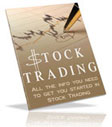
Getting Started with Stock Trading
Anyone with money to invest can buy and sell stocks. Stock trading has its own specialized vocabulary but once you have the basics under your belt you can understand better how the market works. As with any investment, the more knowledge you have about stock trading the more successful you are likely to be.
Most stock trades are done through a broker - an intermediary who takes orders and executes them. Brokers can also offer advice about which stocks to trade and the condition of the market. These 'full-service' brokers charge a relatively high commission. To cut costs, many people use discount brokers that charge significantly less. You don't get advice, but to some, that is an advantage.
Some of the services commonly offered by brokers include online trading, broker assisted trading and some brokers offer options like Interactive Voice Response System for placing orders by telephone and wireless trading systems for making orders by using web-enabled cellular phones or other handheld devices.
Some brokers have their own proprietary software for placing orders over the Internet while others allow you to access their order department through their website with a password. Whichever systems they use, almost every broker offers a variety of charting options that allows you to track movements on the stock market. Analysis software may also be included in their service or available for an extra fee.
Types of Orders
There are different types of orders that can be made when buying or selling stocks. A 'market order' is an instruction to buy or sell at the current market price. The order is usually executed very near the price you are quoted at the time of your order. However, if the stock price is fluctuating or is not actively traded there may be a difference between the quote and the actual transaction.
A 'stop order' or 'limit order' can be placed if you expect the stock price to move and wish to buy or sell at a certain price above or below the current market price. A stop order instructs the broker to trade at a certain price, while a limit order is an instruction to trade at a specified price or better.
A stop order helps to limit losses or protect profits. They become effective when the market hits the stop price but may trade above or below the stop price because they are traded at market price after they become active. Limit orders may not be placed at all even if the market reaches the limit price. If the market moves quickly there may not be time to execute your order before the price falls out of the limit price range.
For example: You buy Bell Canada (BCE) at $50 and then put in a stop order of $45. If the price of BCE falls to $45 your stop order will become effective and your stock will sell at market price. Conversely, if you place a limit sell after buying BCE for $60, when the price rises to that level your stock will be sold at a profit. You could also buy BCE with a limit buy order for $45. This allows you to (possibly) buy stock at less than current market. If the price does not fall to your limit buy price, however, you will not buy any of that stock.
All orders can be placed as 'good ‘til cancelled' (GTC) or as a 'day order.' GTC orders remain in effect until they are cancelled but day orders remain effective only until the end of the current trading day.
Stocks are usually traded in 'round lots' - lots of multiples of 100. It is possible to trade other amounts of stocks, but this kind of trade is called an 'odd lot'. Trading software can handle both types of orders, but odd lot orders are slightly more difficult to fill than round lot orders.
< Back To Learn Stock Trading
Stock Brokers - the types of broker available, what they do, and what they don't do.
What Is The Difference Between Stocks and Bonds? - a common area of confusion, stocks and bonds are very different beasts, here's how.
